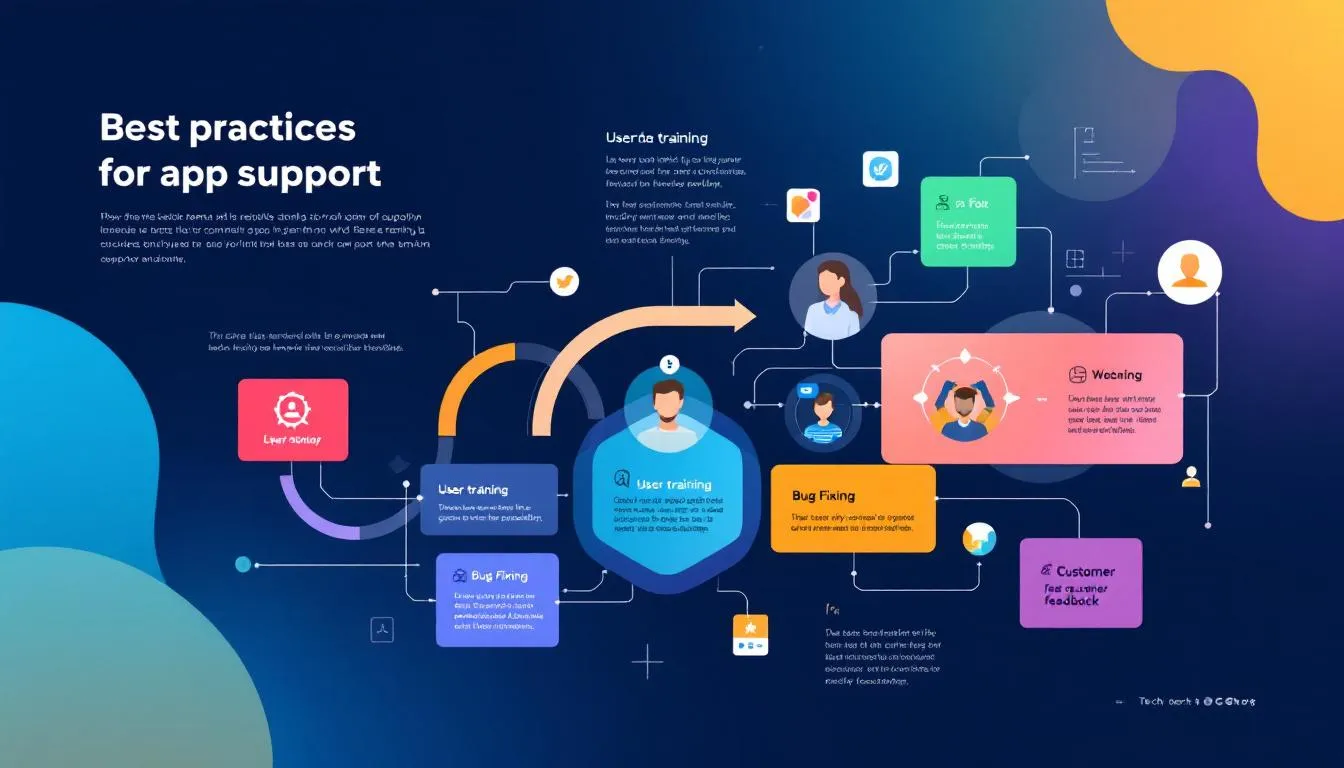App support is essential for ensuring that your application remains functional and users stay satisfied. It encompasses tasks like resolving user issues, fixing bugs, and optimizing overall performance. Without proper support, even the best applications can face disruptions that affect user experience and reliability.
Utilizing application support and maintenance services can significantly improve your app’s performance and user satisfaction. These services not only provide proactive issue resolution and regular updates but also ensure efficient troubleshooting through structured incident management. By partnering with experts in application support, you can maintain your app’s quality, streamline processes, and keep users engaged.
Understanding App Support
Application support is crucial for ensuring that applications are functional, secure, and up-to-date. But what exactly does it entail? At its core, application support encompasses a range of activities aimed at assisting end-users, addressing their queries, and resolving issues effectively. Think of it as the backbone that keeps your application running smoothly and your users happy.
One of the primary goals of application support is to assist end-users by addressing their questions and resolving any issues they encounter. This not only keeps the application’s functionality intact but also enhances user satisfaction through timely resolutions. Imagine you’re using an app and encounter a problem; quick and effective support can turn a potentially frustrating experience into a positive one.
Application maintenance, a subset of application support, includes ongoing activities such as bug fixing and modifying the software application to ensure optimal performance in application development. This is where effective application maintenance comes into play. Addressing issues before they escalate ensures the application remains functional and reliable for users.
In essence, application support is not just about fixing things when they break. It involves a holistic approach to maintaining and improving the application’s functionality, meeting user needs, and enhancing user satisfaction. This proactive stance can make a significant difference in how users perceive and interact with your application’s functionality.
Key Components of App Support Services
Effective application support is built on several key differences. The primary focus is on issue resolution. Investigating and resolving issues, errors, and unexpected behaviors that users might encounter is a key aspect. Timely bug fixes or error resolutions enhance app performance, crucial for user satisfaction. Fixing bugs enhances the overall support experience.

Another vital component is application support maintenance, which includes regular updates and monitoring to ensure that software applications operate smoothly and securely. Performance optimization monitoring is an essential aspect that identifies and resolves performance bottlenecks, ensuring that the application’s functionality remains optimal. This proactive approach helps in maintaining a seamless user experience.
User training is another critical element of app support services. Assisting users in understanding new features and functionalities enhances their experience and satisfaction. Conducting training sessions and providing comprehensive documentation empower users to maximize their application use, increasing engagement and loyalty.
The combined efforts of issue resolution, user training, and performance monitoring result in higher user satisfaction and application effectiveness. Together, these components create a robust support organization that addresses user needs promptly and efficiently, leveraging technical expertise. This comprehensive approach fixes immediate problems and prevents future ones, ensuring a smooth and enjoyable user experience to effectively allocate resources and resolve issues, including technical debt management.
Regular updates are another crucial aspect of effective application maintenance. They ensure that the application remains compatible with the latest operating systems and technologies, thereby reducing the chances of system failures and security breaches. Updating your application involves maintaining system compatibility and ensuring long-term reliability, not just adding new features, including software updates and security updates.
Benefits of Effective App Support
The benefits of effective app support are manifold. A proactive maintenance strategy significantly reduces the likelihood of critical issues, ensuring the application remains functional and reliable. Regular system health checks can identify potential issues before they escalate, preventing disruptions and maintaining seamless operation.
One of the most significant advantages is enhanced user satisfaction. By continuously improving application performance based on user feedback, you can create a more delightful user experience. Actively addressing user feedback increases the likelihood of users continuing to use the app, thereby boosting customer retention rates. Developers can implement changes based on user feedback, enhancements to the application’s functionality and improve performance user satisfaction.
Another substantial benefit is cost savings. Outsourcing application support helps businesses save costs and redirect resources towards core activities. This cost effective approach allows organizations to focus on their primary business needs while maintaining robust app support services.
Scalable application support is crucial for organizations looking to manage increasing workloads as they grow. Adopting AI in app support significantly improves operational efficiency, reduces costs, and increases customer satisfaction through more efficient service. AI-driven approaches can also enhance responsiveness, providing timely assistance and ensuring that users’ needs are met promptly.
Maintaining applications through support practices helps extend their useful lifespan in the face of evolving technologies. Regular maintenance and support ensure continuous operation, avoiding disruptions and maximizing the application’s value. In a world where technology is constantly evolving, effective application maintenance is key to keeping your applications relevant and functional.
Coolest Practices for App Support
Best practices in app support are essential for maintaining high service standards. A proactive approach identifies issues before they affect operations, leading to smoother functioning and enhanced user satisfaction. Proactive support includes regular maintenance and updates, addressing issues early and performance issues before they become critical problems. Additionally, utilizing a support app can further streamline these processes.

Incident management is also crucial. Ineffective incident management can lead to prolonged downtimes and user dissatisfaction. A structured incident management process enhances responsiveness and overall service stability. Clear communication and performance metrics help set realistic expectations and keep users informed about data management and data loss.
Integrating AI in support services is a game-changer. AI chatbots enhance customer engagement by:
- simulating human-like interactions
- providing 24/7 support
- facilitating self-service options Advancements in AI’s emotional intelligence can lead to more empathetic customer interactions, enhancing personalization and overall user experience.
Documentation management is also key in application support. Incomplete or outdated documentation can slow down troubleshooting efforts. Establishing a culture that prioritizes thorough documentation can improve efficiency and collaboration among support teams. Incorporating user feedback helps developers prioritize features based on actual demand, ensuring the application meets user needs effectively.
Future Trends in App Support
The future of app support is brimming with exciting trends and new technologies. AI-driven support systems analyze user data requests and provide immediate solutions, significantly reducing resolution times. This shift towards AI-driven support is expected to enhance user satisfaction by offering faster and more efficient service, supported by innovative technologies.

Predictive analytics is also a promising trend. It can help foresee potential issues in app functionality, enabling proactive measures that enhance user experience. Predicting and addressing problems before they affect users ensures the application remains functional and reliable.
Continuous improvement is essential to keep up with evolving user needs and expectations. Regular updates, security patches, and new applications feature integrations are crucial for maintaining data integrity, application functionality, user satisfaction, and improvements in software development. Staying current with the latest features, technologies, and trends ensures your application remains competitive in the market.
As user expectations continue to rise, businesses must focus on delivering seamless and personalized experiences. The integration of AI and predictive analytics, along with a commitment to continuous improvement, will be key to meeting customer expectations and driving evolving business growth.
Summary
In summary, effective app support services are vital for ensuring that applications remain functional, secure, and up-to-date. By focusing on key components like issue resolution, performance monitoring, and user training, you can enhance user satisfaction and maintain a reliable application.
Looking ahead, embracing future trends like AI-driven support and predictive analytics will be crucial for staying competitive and meeting evolving user needs. By implementing these strategies, you can ensure that your applications not only perform well but also delight users consistently.


